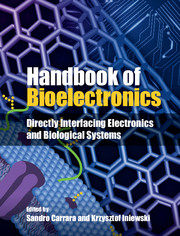1 - What is bioelectronics?
Published online by Cambridge University Press: 05 September 2015
Summary
Although the term was first proposed in 1968, the birth ofbioelectronics as we know it today is much more recent. Infact, the first meaning of the word bioelectronics was the intermolecularelectron transfer found in biological systems [1], while its modern meaning isquite different, as discussed in this chapter.
Tony Turner, founder and Editor-in-Chief of the Elsevier journalBiosensors and Bioelectronics, wrote in 2005:“Bioelectronics is a recently coined term for a field of research thatworks to establish a synergy between electronics and biology” [2]. Overthe years, his journal became the main forum in the field of bioelectronics. Thejournal originally appeared in 1985 with the simple name ofBiosensors, and the title was expanded to include the termBioelectronics in 1992 [2]. The expressed scope of thejournal [3] explains that a key aspect of bioelectronics is the interfacebetween biological materials and electronics.
To better understand the modern state of the field, we can also consider themeaning of “advanced bioelectronics” as mentioned in April 2013 by the NationalInstitute of Standards and Technology (NIST – an agency of the US Department ofCommerce) and represented by the example of electronic DNA sequencing, assupported by singlemolecule mass spectrometry to develop innovative electronicdevices for healthcare [4]. The authors [4] refer to devices in which anelectric field drives individual molecules of single-stranded DNA through ananometer-scale pore (Figure 1.1). That approach is a step toward applicationsfor rapid sequencing of DNA [5] and DNA transcription complexes [6], and couldlead to further developments in protein sequencing [7] too. The application isclearly focused on devices for healthcare and, more generally, includes bothdiagnostic and therapeutic tools.
Information
- Type
- Chapter
- Information
- Handbook of BioelectronicsDirectly Interfacing Electronics and Biological Systems, pp. 1 - 4Publisher: Cambridge University PressPrint publication year: 2015
References
Accessibility standard: Unknown
Why this information is here
This section outlines the accessibility features of this content - including support for screen readers, full keyboard navigation and high-contrast display options. This may not be relevant for you.Accessibility Information
- 2
- Cited by
